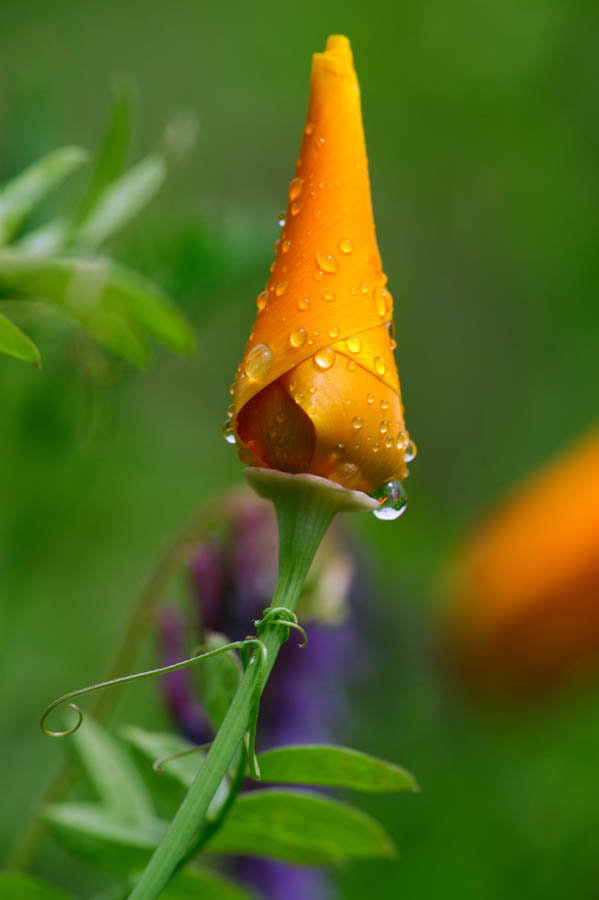California Poppy: Tips and Precautions for Care and Watering

California Poppy (Eschscholzia california) is among the most care-free and lovely California-native flowering plants, and among the easiest to cultivate in urban landscapes. See Planting and Growing California Poppy (Eschscholzia california) for more info about planting, environmental needs, and benefits it provides.
Watering: The best method for watering California Poppy is generally drip irrigation, especially in heavy soils, which allows for infiltration of water over time. Consider installing drip irrigation before planting, which can save hassle and damage to plants later on. California Poppies can also be hand-watered. Frequent sprinkler or overhead watering may encourage disease.
Broadcast or sow seeds into moist or pre-irrigated soil. California Poppy can become extremely drought-tolerant once established in clay and loamy soils, after several months to a year when grown as a perennial, but is less so than some gardeners might expect when grown as an annual. It doesn’t establish as well in coarse and sandy soils, and more frequent watering may be needed. In warm-winter areas, California Poppy may need no supplemental water from fall through spring when rainfall is sufficient.
During dry periods within the first several months to a year after planting, California Poppy performs best with supplemental water about once every 4 to 8 weeks in clay soils during cool weather, and about every 2 weeks in clay soils during warm-to-hot weather. In sandy soils, California Poppy may need supplemental water about every 2 to 4 weeks during cool weather, and about every 1 to 2 weeks during warm-to-hot weather. Seedlings and younger plants may need more-frequent watering.
Care, maintenance, and tips: Minimize fertilization for California Poppy. Plants perform well in most soils provided that drainage is sufficient.
California Poppy tolerates frost to about 20°F or below. Established perennial plants may tolerate cold snaps to 15°F or below.
Walking on soil or working near California Poppy plants may compact soil and encourage diseases, especially when soil is wet after irrigation or rain.
California Poppy blooms are known for closing at night, on cloudy days, and before or during rain.
California Poppies don’t make good cut flowers. They lose their petals quickly after flowers are cut. For a short-lived bouquet, you can try harvesting mature buds before they first open.
During cool-to-warm weather after plants have completed bloom cycles, provide supplemental water and deadhead to encourage reblooming. Deadheading also provides a cleaner look that accentuates the attractive foliage, and prevents seeds from developing if you don’t want California Poppy to spread throughout your landscape (see below). When cut back or deadheaded after blooming, California Poppy can bloom almost year-round in mild-winter, mild-summer areas.
In hot-summer areas, California Poppy plants will die or die back during prolonged periods at temperatures above about 90°F. Plants may go dormant in response to summer heat. In areas where plants might survive, they are often cut back severely, to stubs of about 1 inch, after going dormant.
Reseeding: California Poppy seedpods often burst open forcefully and scatter seeds to a surprising distance. Seeds tend to move downhill with waterflow or wind, and get caught in channels and nooks here and there. It seems to exhaust every possible complaint about plants if we consider a lovely, native flower like California Poppy to be potentially invasive, but remember that unless spent blooms or seed pods are removed, particularly in dry and non-irrigated areas, plants will likely re-seed themselves, sometimes in surprising locations or areas where you might not want them.
Scattered seeds often sprout with fall or winter rains. Both original native strains and other varieties may reseed or naturalize. Varieties bred for color will often revert back to orange-yellow or yellow.
Weed seeds also often sprout with fall and winter rains. If you want California Poppy to naturalize and reseed itself year after year, be diligent in removing weeds and weed grasses every year before they go to seed to minimize competition and prevent buildup of a bank of weed seeds in your soil.
GardenZeus has customized growing information by plant and zip code. To get started, enter your zip code here.
For more information on growing California Poppy, see:
Planting and Growing California Poppy (Eschscholzia california)
Soil and Microclimate Tips for California Poppy (Eschscholzia california)
Spacing and Seasonal Timelines for California Poppy (Eschscholzia california)